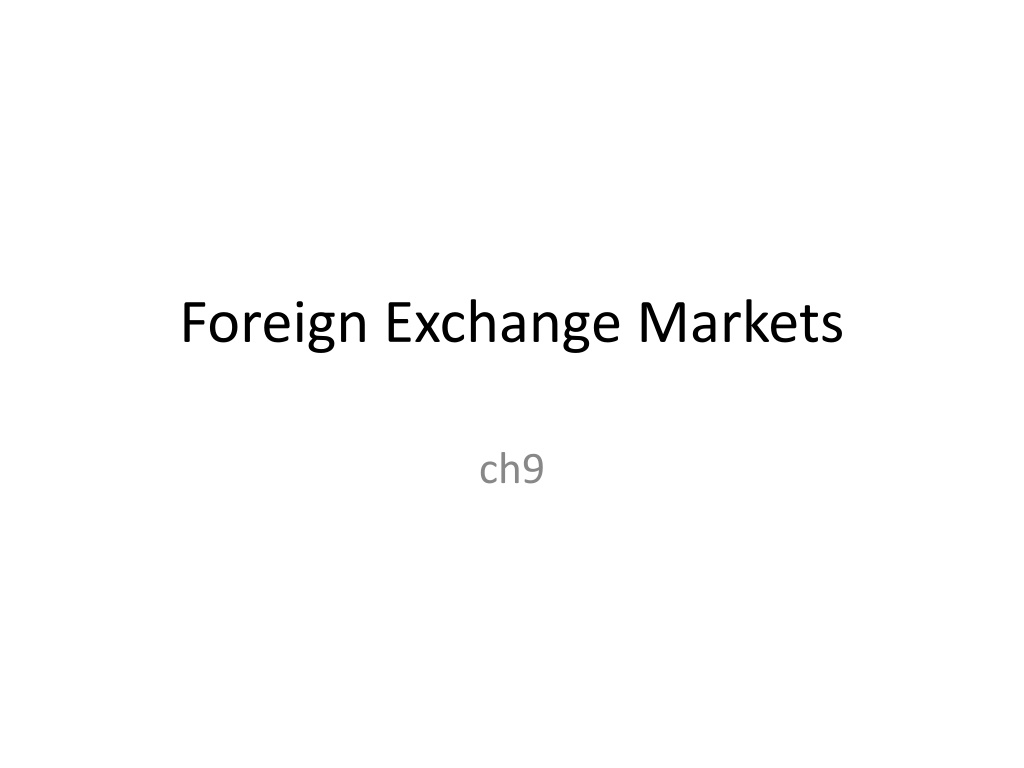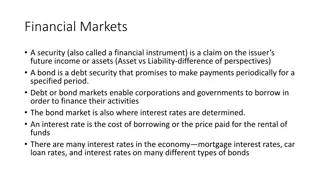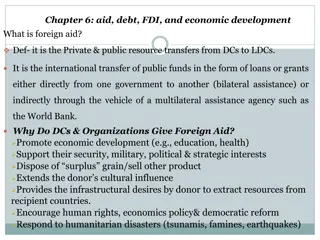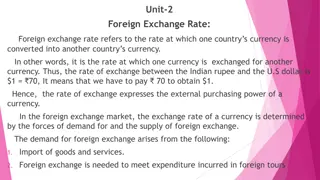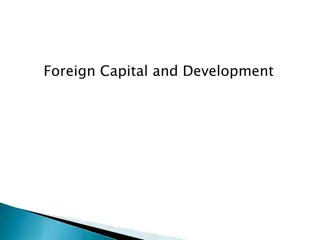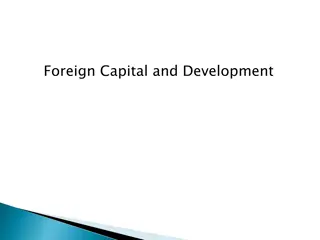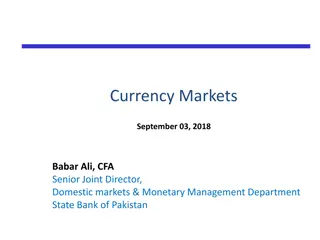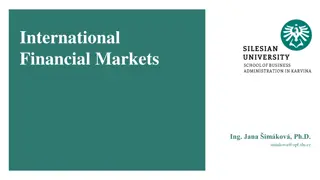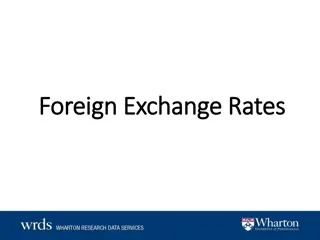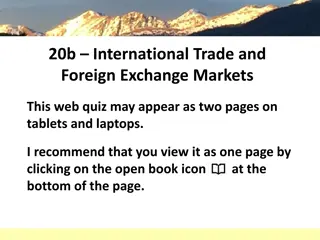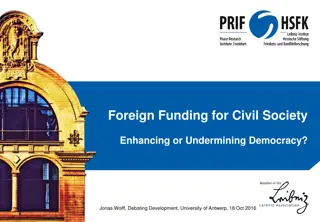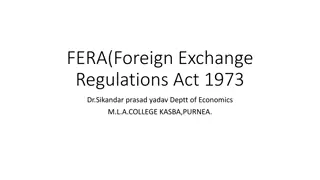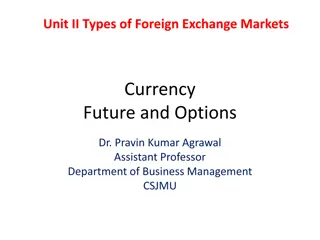Understanding Foreign Exchange Markets and Risks
Financial managers need to grasp the operations of foreign exchange markets for global business success. These markets allow participants to trade currencies, raise capital, transfer risk, and speculate on currency values. Transactions expose businesses to foreign exchange risk, where fluctuations in exchange rates impact cash flows. Currency depreciation and appreciation affect international trade by influencing the competitiveness of goods in foreign markets.
Download Presentation

Please find below an Image/Link to download the presentation.
The content on the website is provided AS IS for your information and personal use only. It may not be sold, licensed, or shared on other websites without obtaining consent from the author. Download presentation by click this link. If you encounter any issues during the download, it is possible that the publisher has removed the file from their server.
E N D
Presentation Transcript
In addition to understanding the operations of domestic financial markets, a financial manager must also understand the operations of foreign exchange markets and foreign capital markets. foreign exchange markets(FX) The foreign exchange market is the market in which participants are able to buy, sell, exchange and speculate on currencies
foreign exchange markets facilitate: - foreign trade - the raising of capital in foreign markets - the transfer of risk between participants - speculation on currency values.
foreign exchange rate is the price at which one currency (e.g.,the U.S. dollar) can be exchanged for another currency (e.g., Saudi Riyal SAR) in the foreign exchange markets. If US company has a global business in Saudi, they generate income in SAR and then the amount is exchanged for US dollar. the actual amount of U.S. dollars received on a foreign transaction depends on the (foreign) exchange rate between the U.S. dollar and the Riyal SAR.
Foregin Exchange transaction are exposed to foreign exchange risk as the cash flows are converted into and out of local currency. foreign exchange risk Risk that cash flows will vary as the actual amount of U.S. dollars received on a foreign investment changes due to a change in foreign exchange rates.
currency depreciation When a country s currency falls in value relative to other currencies, meaning the country s goods become cheaper for foreign buyers and foreign goods become more expensive for foreign sellers.
depreciation of a countrys currency (or a fall in its value relative to other currencies) means the country s goods become cheaper for foreign buyers and foreign goods become more expensive for foreign sellers.
currency appreciation When a country s currency rises in value relative to other currencies, meaning that the country s goods are more expensive for foreign buyers and foreign goods are cheaper for foreign sellers.
The appreciation of a countrys currency (or a rise in its value relative to other currencies) means that the country s goods are more expensive for foreign buyers and foreign goods are cheaper for foreign sellers (all else constant) when a country s currency appreciates, domestic manufacturers find it harder to sell their goods abroad Also, foreign manufacturers find it easier to sell their goods to domestic purchasers
FOREIGN EXCHANGE RATES AND TRANSACTIONS Foreign Exchange Rates Foreign exchange rates are listed in two ways: 1. U.S. dollars received for one unit of the foreign currency exchanged (IN US$, also referred to as the direct quote) 2. foreign currency received for each U.S. dollar exchanged (PER US$, also referred to as the indirect quote)
Foreign Exchange Rates Example the exchange rate of U.S. dollars for Saudi Riyal is $0.2667(US$/SAR) the exchange rate of Saudi Riyal for U.S. dollars was $3.7495 (SAR/US$).
Foreign Exchange Transactions There are two types of foreign exchange rates and foreign exchange transactions: 1. Spot foreign exchange transactions 2. forward foreign exchange transaction
spot foreign exchange transactions Foreign exchange trans- actions involving the immediate exchange of currencies at the current (or spot) exchange rate.
Example: a U.S. investor wanting to buy British pounds through a local bank at a rate of $1 per 0.6413 pound (or $1.5594 per pound). If the dollar depreciates in value relative to the pound (e.g., $1 per 0.6372 pound or $1.5694 per pound), the value of the pound investment, if converted back into U.S. dollars, increases If the dollar appreciates in value relative to the pound (e.g., $1 per 0.6432 pound or $1.5547 per pound), the value of the pound investment, if converted back into U.S. dollars, decreases.
forward foreign exchange transaction The exchange of currencies at a specified exchange rate (or forward exchange rate) at some specified date in the future. An example is an agreement today (at time 0) to exchange dollars for pounds at a given (forward) exchange rate three months into the future There is an increase use of forward relative to spot foreign exchange transactions because of the increased ability to hedge foreign exchange risk with forward foreign exchange contracts
Measuring Risk and Return on Foreign Exchange Transactions. foreign exchange risk is introduced by adding foreign currency assets and liabilities to a firm s balance sheet The risk involved with a spot foreign exchange transaction is that the value of the foreign currency may change relative to the U.S. dollar over a holding period.
Foreign Exchange Risk Suppose that on a U.S. firm plans to purchase 3 million Swiss francs (Sf) worth of Swiss bonds from a Swiss FI in one month s time. The Swiss FI wants payment in Swiss francs, the U.S. firm will convert dollars into Swiss francs today. The spot exchange rate for August 19, 2010 (reported in the Table) of U.S. dollars for Swiss francs is 0.9691, or one franc costs 0.9691 in dollars. Consequently, the U.S. firm must convert: U.S$/Sf exchange rate * Sf 3 million = 0.9691 * Sf 3m = $2,907,300
One month after the conversion of dollars to Swiss francs, the Swiss bond purchase deal falls through and the U.S. firm no longer needs the Swiss francs it purchased at $0.9691 per franc. The spot exchange rate of the Swiss franc to the dollar has fallen or depreciated over the month so that the value of a franc is worth only $0.9566, or the exchange rate is $0.9566 per franc. The U.S. dollar value of 3 million Swiss francs is now only: 0.9566 * ? Sf 3 million= ? $2,869,800 The depreciation of the Swiss franc relative to the dollar over the month has caused the U.S. firm to suffer a $37,500 ($2,869,800 ? $2,907,300) loss due to exchange rate fluctuations.
To avoid such a loss in the spot markets, the U.S. firm could have entered into a forward transaction, which is the exchange of currencies at a specified future date and a specified exchange rate For example, if the U.S. firm had entered into a one- month forward contract selling the Swiss franc, at the same time it purchased the spot francs, the U.S. firm would have been guaranteed an exchange rate of 0.9694 U.S. dollars per Swiss franc on delivering the francs to the buyer in one month s time it would have largely avoided the loss of $37,500 , by selling 3 million francs forward, it would have received: 0.9694 ? * Sf 3 million = ? $2, 908, 200 at the end of the month, suggesting a small net profit of $2,908,200- ? $2,907,300 = ? $900
Calculating the Return on Foreign Exchange Transactions of a U.S. FI financial institutions, and particularly commercial banks, are the main participants in the foreign exchange markets. When issuing a foreign currency- denominated liability or buying a foreign- currency-denominated asset an FI will do so only if the expected return is positive.
Suppose that a U.S. FI has the following assets and liabilities: Assets * $100 million U.S. loans (one year) in dollars 9% * $200 million Liabilities U.S. CDs (one year) in dollars 8% * $100 million equivalent U.K. loans 15% (one year) (loans made in pounds) the FI has matched the maturity (M) or duration of its assets (A) and liabilities (L): MA ? ML = 1 year but has mismatched the currency composition of its asset and liability portfolios
Suppose that the promised one-year U.S. dollars CD rate is 8 %, to be paid in dollars at the end of the year, and that one-year, credit risk free loans in the United States are yielding 9 % The FI would have a positive spread of 1 % from investing domestically.
Suppose, however, that credit riskfree one-year loans are yielding 15 % in the United Kingdom. To invest $100 million (of the $200 million in CDs issued) in one-year loans in the United Kingdom, the U.S. FI engages in the following transactions: 1. At the beginning of the year, it sells $100 million for pounds on the spot currency markets. If the exchange rate is $2.00 to 1, this translates into $100 million/2.0 = ? 50.0 million. 2. It takes the 50.0 million and makes one-year U.K. loans at a 15% interest rate.
3. At the end of the year, pound revenue from these loans will be 50.0(1.15)= ? 57.500 million. 4. It converts these funds back to the United States at the end of the year (how?): FI sells the 57.500 million in the foreign exchange market at the spot exchange rate that exists at that time. Suppose that the spot foreign exchange rate has not changed over the year it remains fixed at $2.00/ 1. Then the dollar proceeds from the U.K. investment are: 57.500 million ? * $2.00/ 1 =? $115 million or as a return: $115 million- ? $100 million/$100,000= ? 15%
Given this, the weighted or average return on the FI s portfolio of investments would be: (.5)(.09)* ? (.5)(.15) ? = .12, or 12% This exceeds the cost of the FI s CDs by 4 % (12% -? 8%).
Suppose, however, that the pound had fallen (depreciated) in value against the U.S. dollar from $2.00/ 1 at the beginning of the year to $1.8125/ 1 at the end of the year, the pound loan revenues at the end of the year translate into: 57.500 million * ? $1.8125/ 1=? $104.22 million or as a return on the original dollar investment of: $104.22 -? $100/$100 = ? .0422 ? 4.22%
The weighted return on the FIs asset portfolio would be: (.5)(.09) + ? (.5)(.0422) =? .0661 =? 6.61% In this case, the FI actually has a loss or a negative interest margin (6.61% - ? 8% = -? ? 1.39%) on its balance sheet investments.
The reason for the loss is that the depreciation of the pound from $2.00 to $1.8125 has offset the attractively high yield on British pound loans relative to domestic U.S. loans. If the pound had instead appreciated (risen in value) against the dollar over the year to $2.125/ 1, the U.S. FI would have generated a dollar return from its U.K. loans of: 57.500 million *? $2.125= ? $122.188 million or a percentage return of 22.188 % The U.S. FI would receive a double benefit from investing in the United Kingdom, a high yield on the domestic British loans and an appreciation in pounds over the one-year investment period.
Hedging Foreign Exchange Risk. Since a manager cannot know in advance what the pound/dollar spot exchange rate will be at the end of the year, a portfolio imbalance or investment strategy is risky. an FI can better control the scale of its FX exposure in either of two major ways: 1. On-balance-sheet hedging 2. Off-balance-sheet hedging
1. Hedging on the Balance Sheet Suppose that instead of funding the $100 million investment in 15 percent British loans with U.S. CDs, the FI manager funds the British loans with $100 million equivalent one- year pound sterling CDs at a rate of 11 percent. Now the balance sheet of the FI would be as follows: Assets $100 million U.S. loans (9%) $100 million U.K. loans (15%) (loans made in pounds) Liabilities $100 million US CDs (8%) $100 million U.K CDs (11%) deposits raised in pounds In this situation, the FI has both a matched maturity and foreign currency asset liability book now consider the FI s profitability or spreads between the return on assets and cost of funds under two scenarios: 1. when the pound depreciates in value against the dollar over the year from $2.00/ 1 to $1.8125/ 1 2.when the pound appreciates in value during the year from $2.00/ 1 to $2.125/ 1.
1. Hedging on the Balance Sheet 1. The Depreciating Pound. When the pound falls in value to $1.8125/ 1, the return on the British loan portfolio is 4.22%. Consider what happens to the cost of $100 million in pound liabilities in dollar terms: 1. At the beginning of the year, the FI borrows $100 million equivalent in pound CDs for one year at a promised interest rate of 11%. At an exchange rate of $2.00/ 1, this is a pound equivalent amount of borrowing of $100 million/2.00= ? 50.00 million. 2. At the end of the year, the FI must pay the pound CD holders their principal and interest, 50.00 million (1.11)= ? 55.500 million.
Hedging on the Balance Sheet 3. If the pound had depreciated to $1.8125/ 1 over the year, the repayment in dollar terms would be $100.59 million (? 55.500 million times $1.8125/ 1), or a dollar cost of funds of 0.59 percent. Thus, at the end of the year, the following occurs: Average return on assets: (0.5)(0.9) + ? (0.5)(.0422)= ? .0661 or ? 6.61% U.S. asset return ? U.K. asset return ? Overall return Average cost of funds: (0.5)(.08) ? + (0.5)(.0059)= ? .04295 or? 4.295% U.S. cost of funds ? U.K. cost of funds ? Overall cost Net return: Average return on assets ? Average cost of funds 6.61%- ? 4.295%= ? 2.315%
1. Hedging on the Balance Sheet 2. The Appreciating Pound. In the previous example, When the pound appreciates over the year from $2.00/ 1 to $2.125/ 1, the return on British loans equals 22.188 percent. Now consider the dollar cost of British one-year CDs at the end of the year when the U.S. FI must pay the principal and interest to the CD holder: 55.500 million *? $2.125/ 1=? $117.9375 million
1. Hedging on the Balance Sheet Thus, at the end of the year: Average return on assets: (0.5)(.09) + ? (0.5)(.22188) =? .15594, or 15.594% Average cost of funds: Net return: (0.5)(.08) ? + (0.5)(.179375)= ? .12969, or 12.969% 15.594% -? 12.969% = ? 2.625%
2. Hedging off the balance sheet Instead of matching its $100 million foreign asset position with $100 million of foreign liabilities the FI might have chosen to remain with a currency mismatch on the balance sheet Instead, it could hedge by taking a position in the forward or other derivative markets for foreign currencies for example, the one-year forward market for selling pounds for dollars. Any forward position taken would not appear on the balance sheet
2. Hedging off the balance sheet The role of the forward FX contract is to offset the uncertainty regarding the future spot rate on pounds at the end of the one-year investment horizon. Instead of waiting until the end of the year to transfer pounds back into dollars at an unknown spot rate,
2. Hedging off the balance sheet(forward contract) Consider the following transactional steps when the FI hedges its FX risk by immediately selling its expected one-year pound loan proceeds in the forward FX market: 1.The U.S. FI sells $100 million for pounds at the spot exchange rate today and receives $100 million/2.0 ? 50.00 million. 2.The FI then immediately lends the 50.00 million to a British customer at 15 percent for one year.
3.The FI also sells the expected principal and interest proceeds from the pound loan for- ward for dollars at today s forward rate for one-year delivery. Let the current forward one-year exchange rate between dollars and pounds stand at $1.9375/ ;or as a percentage discount: ($1.9375 -? $2.00)/$2.00 ? = - ? 3.125% This means that the forward buyer of the pounds promises to pay: 50.00 million* (1.15)= ? 57.50 57.50 *$1.9375/ ? = $111.406 million
return on the British loan of: $111.406m- $100m/$100= ? 11.406% Given this return on British loans, the overall expected return on the FI s asset portfolio is: (.5)(.09) +? (.5)(.11406) =? Since the cost of funds for the FI s $200 million U.S. CDs is an assumed 8 percent, it has been able to lock in a return spread over the year of 2.203 percent regardless of spot exchange rate fluctuations. 10.203%
Role of Financial Institutions in Foreign Exchange Transactions A financial institution s position in the foreign exchange markets generally reflects the following trading activities: 1. The purchase and sale of foreign currencies to allow customers to partake in and complete international commercial trade transactions. 2.The purchase and sale of foreign currencies for hedging purposes to offset customer (or financial institution) exposure in any given currency. 3.The purchase and sale of foreign currencies for speculative purposes through forecasting or anticipating future movements in foreign exchange rates.
